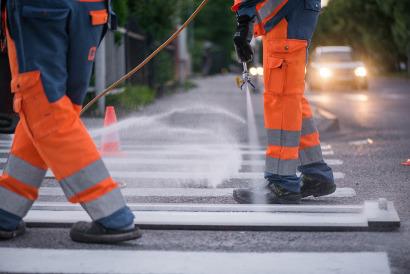Sustainable materials for smarter roads

As the Christmas holiday period approaches, when short days, heavy traffic and adverse weather conditions can make festive travel tricky by road, OU academics are investigating new environmentally sustainable materials for use in road marking that could make our driving safer and easier.
Dr James Bruce, Senior Lecturer in Organic Chemistry and Dr Simon Collinson, Senior Lecturer in Chemistry from the OU’s School of Life Health and Chemical Sciences have received £132,000, to research new markings that could have chemical compounds that allow them to communicate with cars, which will be particularly useful for driverless cars.
The funder and collaborator is WJ group, a company engaged in the manufacture and application of road markings.
Safer laying and removing of road markings
Dr Bruce said: “This project could transform the road marking industry giving them access to materials that are easier to handle, more sustainable to use and allow them to adopt emerging technologies that allow easier and safer laying and removal of road markings.
“For the road user in cars with an increasing variety of cameras and sensors capable of reading their environment it provides another means for the car and driver to monitor the road around them and have a safer driving experience.”
Using materials that reduce environmental impact
The project will develop new polymer-based materials where the rate and direction of reaction of the material can be controlled by external environmental factors such as light, temperature and time. The aim will be to understand and hence control over the reaction conditions to produce materials with desired bulk properties such as curing time, adhesion and hardness.
The initial focus will be on polymerisation reactions that are thermally regulated and opens the possibility of designing polymer-based coatings that can be added and removed, and hence recycled, at different temperatures to reduce the environmental impact. Further work will be done to enhance water resistance and luminosity/reflectivity of the material.
Markings that communicate with cars
Dr Bruce added: “Before I started working with WJ group, I took the road marking for granted. To me it was just a white line on the road, a piece of paint. In fact, the recipe for it is chemically complex and nearly 100 years old and WJ group wanted to investigate if they could make a better road marking, one that would last longer, be easier to see and could take advantage of the inbuilt car technologies which didn’t exist 100 years ago.
“We are looking at adding chemical compounds to the road markings that the camera can see, and it will help the car to maintain its lane discipline. This has quite big implications for self-driving cars and raises the question as to whether you could put some of the technology in the road as opposed to the car.”
The project will run from 2020 to 2024 with new road marking expected to ready to trial in 2021/2.
Watch the video of Dr James Bruce talking about the benefits of Knowledge Transfer Partnerships between universities and industry:
Read more about OU’s research in Chemistry and Analytical Science
Quarterly Review of Research
Read our Quarterly Review of Research to learn about our latest quality academic output.

Contact our news team
For all out of hours enquiries, please telephone +44 (0)7901 515891
News & articles
- Shaping a sustainable future – the power of Open Research 24th April 2024
- New research into Pompeii to be revealed by OU/BBC co-production 12th April 2024
- OU research among UK funding boost for international space projects 8th April 2024
